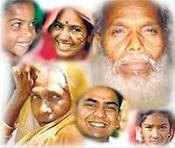 The Ministry of Rural Development Government of India, is now carrying out the Socio Economic and Caste Census (SECC) 2011, between June 2011 and December 2011, through a comprehensive door to door enumeration across the country. This is the first time such a comprehensive exercise is being carried out for both rural and urban India.It was launched on 29th June 2011 in Hazemora Block in West Tripura.
The Ministry of Rural Development Government of India, is now carrying out the Socio Economic and Caste Census (SECC) 2011, between June 2011 and December 2011, through a comprehensive door to door enumeration across the country. This is the first time such a comprehensive exercise is being carried out for both rural and urban India.It was launched on 29th June 2011 in Hazemora Block in West Tripura.
What is the Socio Economic and Caste Census (SECC) 2011
The Socio Economic and Caste Census (SECC), 2011 is being carried out by the Government of India to generate information on a large number of social and economic indicators relating to households across the country. It will rank households based on their socioeconomic status, so that State/Union Territory Governments can objectively prepare a list of families living below the poverty line in rural and urban areas The SECC, 2011 is being conducted simultaneously for rural and urban areas, by the respective State Government and Union Territory Administration, with technical and financial support from the Government of India.
What are the Objectives of SECC, 2011
1. To enable households to be ranked based on their socioeconomic status. State Governments can then prepare a list of
families living below the poverty line
2. To make available authentic information that will enable caste-wise breakup of population in the country
3. To make available authentic information regarding the socioeconomic condition, and education status (together can be called as socio-economic profile) of various castes and
sections of the population
How it differs from 2002 BPL survey
1. The entire exercise will be paperless, done on a handheld electronic device (tablet PC). This will drastically reduce data entry errors and enumerator discretion
2. Checks and balances at several levels - from the enumeration stage, to public scrutiny at the Gram Sabha level – will ensure that there is no misreporting
3. Almost all of the information will be made available in the public domain
What is the difference between SECC, 2011 and the Planning Commission estimates of poverty
The Planning Commission provides estimates of the percentage of the rural and urban population living below the poverty line in different States/UTs. That is, it estimates the “how much” of poverty. The SECC, 2011 on the other hand, will provide information on the “who” of the population living below the poverty line. Thus, for example, the Planning Commission estimate for a State could be that say 55% of the rural population and say 30% of the urban population is living below the poverty line. SECC, 2011 will enable that particular State to identify the households who comprise this 55% and 30% respectively.
How will the households be ranked in rural areas
Households will be ranked through a three-step process.
Step 1.A household with any of the following will be excluded automatically:
- Motorized two/three/four wheeler/ fishing boat/
- Mechanized three/four wheeler agricultural equipment
- Kisan Credit Card with credit limit of Rs. 50,000 and above
- Household with any member as a Government employee
- Households with non-agricultural enterprises registered with the Government
- Any member of the family earning more than Rs. 10,000 per month
- Paying income tax
- Paying professional tax
- Three or more rooms with all rooms having pucca walls and roof
- Own a refrigerator
- Own Landline phone
- Own 2.5 acres or more of irrigated land with at least 1 irrigation equipment
- 5 acres or more of irrigated land for two or more crop seasons
- Owning at least 7.5 acres of land or more with at least one irrigation equipment
Step 2.A household with any of the following will be included automatically:
- Households without shelter
- Destitute/ living on alms
- Manual scavengers
- Primitive tribal groups
- Legally released bonded labourers
Step 3.The remaining households will be ranked using 7 Deprivation Indicators. Households with the highest
deprivation score will have the highest priority for inclusion in the list of households below the poverty
level.
- Households with only one room, kucha walls and kucha roof
- No adult member between the ages of 16 and 59
- Female headed households with no adult male member between 16 and 59
- Households with disabled member and no able bodied adult member
- SC/ST households
- Households with no literate adult above 25 years
- Landless households deriving a major part of their income from manual casual labour
In rural areas, what data will be made available and where
All data will be read out in the Gram Sabha and Panchayat following the draft publication list being printed. Subsequently, individual information except for religion, caste and tribe data will be made available in the public domain.
Why wasn’t the SECC, 2011 conducted under the Census Act, 1948
Individual particulars conducted under the Census Act, 1948, are kept confi dential. The SECC, 2011 requires putting such statistics (except for caste-related data) in the public domain. However, the SECC, 2011 is being conducted using the same administrative apparatus as used in the decennial population census.
About the device used
Portable Handheld Device (Tablet PC) developed by Bharat Electronics Ltd is used for the Socio Economic and Caste Census 2011






0 comments: